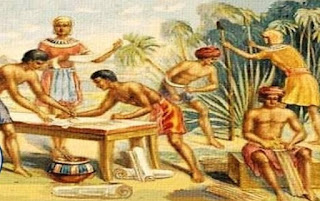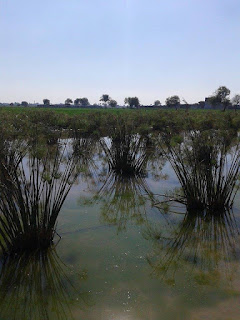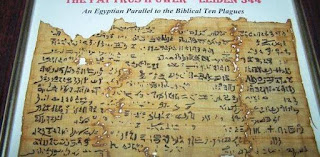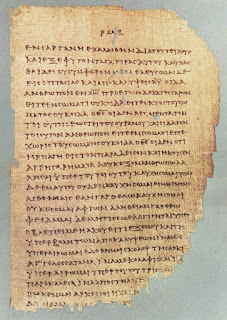The history of papyrus
The first paper invented in history
Since the dawn of history, mankind has been searching for food, drink and other things, and among the things is writing down the events in their lives
The writing was initially on the stone until the ancient Egyptian invented the papyrus
Initially, it was used in ancient Egyptian temples for religious purposes such as preparing the Book of the Dead, then after that it was used for worldly purposes. Pliny mentioned that the manufacture of papyrus flourished during the Roman era in the rule of Ptolemy, and made it government, and exported to a world where papyrus was discovered in all of Asia Minor, Syria and Europe, and this is evidence of the contact of ancient civilizations, and Egypt had the privilege of exporting papyrus, where it was a plant The papyrus only grows in the Nile Delta
Important events were recorded papyrus
some most important papyri that have beendiscovered
Great Pyramid Papyri
Papyri discovered in Egypt describing the construction of the Great Pyramid of Khufu. In 2013, an Egyptian French team of archaeologists found hundreds of papyrus in a cave in Wadi Al-Jarf that contain records dating back to the twenty-seventh year of the rule of Pharaoh Khufu written with hieroglyphic symbols describing the construction of the Great Pyramid of Giza
Below these records, more than 4,500 years ago, an intermediate inspector named Merrer wrote in them details of months of construction work in the pyramid, as well as details of work in Tora quarries on the bank opposite the Nile.
Merer records were organized in the form of a two-column chart in which details of the daily life of construction workers were recorded, in addition to the details of extracting the limestone that the pyramid was covered in which was transported from the quarry in Tora to the pyramid site by boat across the Nile River on a journey that takes two or three days, and also included The papyri shown are accounting documents that are very similar to the books of the current accounts. They record the revenues transferred from the various Egyptian governorates in red while the food and wages expenses are recorded in black
Merer records were organized in the form of a two-column chart in which details of the daily life of construction workers were recorded, in addition to the details of extracting the limestone that the pyramid was covered in which was transported from the quarry in Tora to the pyramid site by boat across the Nile River on a journey that takes two or three days, and also included The papyri shown are accounting documents that are very similar to the books of the current accounts. They record the revenues transferred from the various Egyptian governorates in red while the food and wages expenses are recorded in black
The Egyptian Museum
Eloquent peasant papyrus
The story begins with the stumbling of the farmer Khan-Anoop and his donkey in the lands of the nobleman Rinci Ben Meru. The supervisor of the land, "Nimtynakht" accused him of damaging the crops, and that his donkey ate from the noble's seed, so he took the donkey and assaulted Khan-Anoop. Khan-Anoop went to the noble Rinsi near the river bank in the city, and commended him, and transmitted his complaint to him, and the nobleman demanded that he bring witnesses to the veracity of his words. However, Khan-Anoop was unable to do so, but the nobleman was impressed by the eloquence of the farmer, and presented the matter to Pharaoh and told him about the eloquence of the farmer, so the king was impressed by the speech, and ordered him to submit a written petition of his complaint.
For nine days Khen-Anoop pleaded for justice, after feeling neglected by the noble, Khen-Anoop insulted the noble and was beaten. So the frustrated peasant left, but the nobleman sent to him someone to order him to return, and instead of punishing him for his rudeness, he did justice to him and ordered the donkey to be returned to the farmer, and admiring him for his eloquence, he appointed him as a supervisor of his lands instead of the unjust overseer Namtenakht.
Papyrus confirms the use of the ancient Egyptians
For magic
For thousands of years, Egypt was famous for magic, and magic was among the ancient Egyptians, one of the important things in their lives. Rather, magic was associated with the ancient Egyptians with religion. Accordingly, the priests' status with the Pharaohs increased their teaching of magic. The most common magic in the ancient Egyptian was defensive magic, With the goal of driving out evil spirits
Westcar Papyrus
It is called "Westcar" or "Khufu and the witches", and in it we find a reference to the prophecy of the Egyptian magician "Jedi" to King "Khufu", where he mentioned that there in the city of "On" will be born to the chief priest of the sun three males who assume the rule of Egypt, respectively
The papyrus is one of the texts of ancient Egyptian literature, and it contains five stories about the marvels performed by priests and magicians, each of those stories told by one of the sons of Pharaoh Khufu in his council
The papyrus tells us that the king has experienced some boredom, and after thinking he called on his sons to tell each other a story or story to tell about it, and the focus of these short tales revolves around the "wizard". Ancient, specifically during the reign of King Snefru
For a start, here is the brilliant "Gaga M. Ankh" during the rule of King Sneferu. One day, the pharaoh felt that he did not know how to get rid of the distress and boredom that filled his chest, so he asked him to treat his distress, so our charming friend suggested that he take a picnic in a boat with twenty girls Beautiful
Certainly, this advice did not have any traces of magic, and "Sanefro" found that it was very enjoyable, but soon the flight was disturbed by an unfortunate accident. For her sorrow. Pharaoh did not like this, so he sent in the request of the priest, "Gaga im Ankh", so that he might restore with his magic that charm to restore the beautiful blasphemer with its joy.
And when the magician came, he uttered a few magic words that led to placing one half of the lake water over the other half, and he found the ornament that was lying on top of a flank, and went to bring it in order to return it to its owner. The height of the water in one of the two halves of the lake reached 12 cubits, and it became no less than 24 cubits. , As the lake is folded on itself. Then the magician again uttered his talisman, so the water returned to what it was. The smile returned to the face of the beautiful girl, as well as to her companions, and it greatly snowed King Snefru's heart.
Egyptian Berlin Museum
The Dead Book Papyrus
The Book of the Dead is a collection of religious documents and funerary texts that were used in ancient Egypt, to be a guide to the dead on his journey to the other world, used from the beginning of the modern era of the ancient Egyptian state (around 1550 BC) to about 50 BC. The term "book" is the closest term to describe this wide range of texts that consist of a number of magical spells aimed at helping the journey of a dead person to the afterlife. These talismans were composed by many priests during a period of about 1000 years.
It is considered the oldest book whose science has ended, written down in the era of building the Great Pyramid,. It contains invitations to the gods, chants and prayers, then a description of the reckoning and the reward for the souls of the dead in the other world. They built huge temples next to the graves that are no less magnificent and luxurious, where they believed the resurrection and the return of the spirit that they were drawing in two close-up pictures Ka or Ba .. They also made sure to put all the things of the deceased of food and jewelry and everything that he loved in his life with him in his grave where The soul of the dead can eat and drink from it when it returns to the body, before seeking another life.
British Museum
medical papyrus
Papyrus Brooklyn is a medical papyrus dating from ancient Egypt and is one of the oldest preserved writings about medicine and ophiology. The manuscript is dated to around 450 BC and is today kept at the Brooklyn Museum in New York
At the beginning of the 18th century, a 17-page Pharaonic papyrus was discovered in the "Manfis" area near the Sakkara pyramids belonging to its first owner, Georgius. It is now found in the National Museum in the Netherlands, which purchased the papyrus in 1828 The museum is under the number (344) and is one of the most important papyri documenting the lean years experienced by Egypt in the era of our master Moses peace be upon him.
The papyrus tells the verses of the torment that Pharaoh suffered, which was mentioned in the Koran, and archaeologists said that they return to the Middle Kingdom and called it "Papyrus Ibor
National Museum of the Netherlands
Papyrus 46
Papyrus 46, one of the oldest New Testament papyri
Papyrus 46, a written abbreviation, is one of the oldest New Testament manuscripts in the Greek language, written on papyrus
The papyrus that benefited humanity
The Egyptian papyrus plant is considered the best papyrus in the world, as it reaches 5 cm in length unlike other plants, where it reaches only 2 cm or 3 cm, which does not give a substance suitable for industry, so since the first family until the tenth century we find Egypt monopolizing this commodity and with the growth of civilization Urbanization in neighboring countries, especially in the Mediterranean countries, increased demand for papyrus in Egypt, and what indicates the economic value of papyrus This example that occurred in the fourth century BC .
The Greek world began to use the Egyptian papyrus from the sixth century BC, and there is a belief from scholars that the papyrus scrolls were transferred to Rome from Egypt around the beginning of the Ptolemaic era, and as a result of the expansion of the Roman Empire, the manufacture of papyrus and its use as a writing material in the White Sea Basin also spread. The average, and even after the Arab conquest of Egypt, the papyrus trade did not stop, and during the sixth, seventh and eighth centuries AD, papyrus was exported to Marseille and from there to the countries of the Faal, as was used throughout France until the year 787AD. As for the senior officials of the Vatican in Rome, they used papyrus imported from Egypt until the year 1087 AD, and in Spain the last text written on papyrus dates back to the year 1017 AD, and in Sicily and southern Italy the papyrus was used until the eleventh century, and perhaps the twelfth century AD In the third quarter of the twelfth century A.D., “Enstasthius” writes to us in Constantinople, papyrus is becoming a lost art. Multiple uses The papyrus documents are a product of archeology and the efforts of archaeologists in the nineteenth century, and thanks to what Egypt has retained of a huge staggering wealth of papyri, it has also preserved many aspects of urbanization and civilization thanks to its structure and dry soil, especially in the southern part of the country, because that The excavations resulted in hundreds of papyri, some of which remained inside Egypt
A friend of the environment
Papyrus in the face of logging and threatening our lives
We seek to use eco-friendly papyrus instead of paper
The most important dangers caused by logging on the environment
Trees are cut down to make paper, furniture, and more
Deforestation leads to soil erosion and water and air shortages, and there is a lot of environmental damage Thousands of tons of trees, as deforestation adversely affects land and soil productivity.
It is worth noting the level of interest these plants receive, due to their important role in the wetland ecosystems. Whereas, in recent years, papyrus has been the subject of extensive environmental studies focused on its impressive rate of growth and its ability to recycle nutrients.
Papyrus has been living for thousands of years and is not affected by any weather factors
Pharaoh Seti I offers the Lotus and Papyrus flowers to the god Horus.
Temple of Seti I at Abydos.
Sohag.
Egypt.
The statue of the Egyptian writer records history on papyrus, and the statue of the Egyptian writer, squatting, goes back to the beginning of the Fifth Dynasty
Browse papyrus drawings and other handmade products through our store
It is used by most schools for students' activities
We have an initiative to produce and distribute papyrus to schools and libraries for free
















